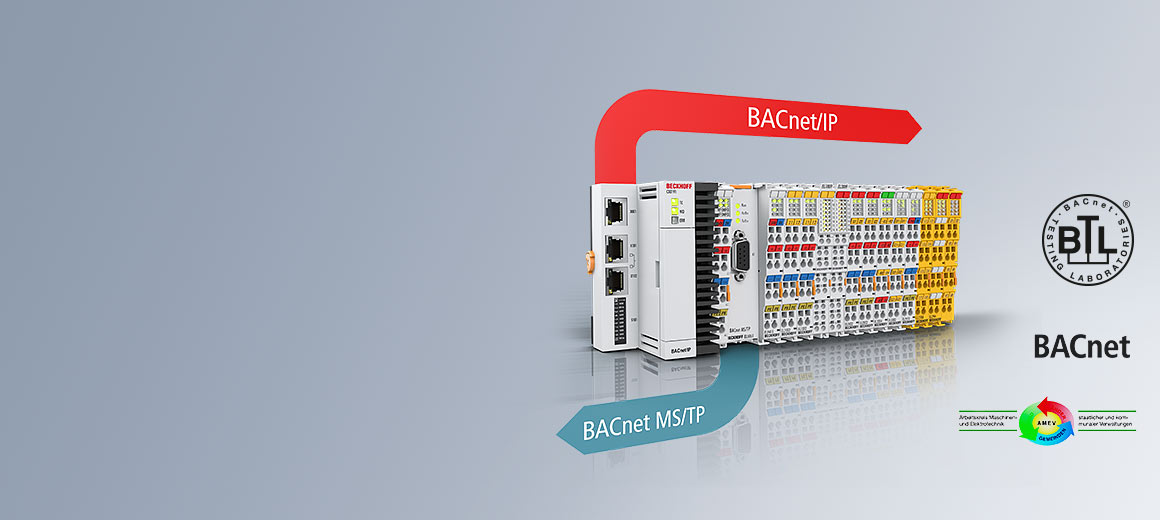
BACnet
The BACnet solution from Beckhoff: scalable performance and wide range of functions
Siège social Belgique
Beckhoff Automation BV

The BACnet solution from Beckhoff: scalable performance and wide range of functions

BACnet (Building Automation Control Network) is a standardized, manufacturer-independent communication protocol for building automation. Areas of application include HVAC, lighting control, safety and fire alarm technology.
TwinCAT BACnet after revision 14
TwinCAT BACnet can run on any Beckhoff Industrial PC. The Embedded Controllers of the CX8191, CX9020, CX51xx and CX52xx series, the IPCs of the C60xx series and the Panel PCs of the CP66xx, CP67xx, CP22xx and CP27xx series in various screen sizes have been certified as BACnet Building Controllers (B-BC). They meet all the requirements of the global ISO 16484-5 BACnet standard, protocol revision 1.14.
TwinCAT BACnet from Beckhoff is one of the most open and flexible solutions currently available on the market. With the certification for revision 14, Beckhoff has implemented the version of the BACnet standard that is currently used in building automation. Extensions of the BACnet standard can easily be added in the future. Plant and building automation engineers have access to the latest features and benefit from a number of advantages.
TwinCAT BACnet allows users to access all BACnet objects and their properties from the PLC and the visualization, i.e. users can observe and change the state of these objects. Ready-made PLC function blocks reduce the programming effort to a minimum. Beckhoff offers unrivalled flexibility through its finely scaled product range: users have a choice between controllers for several hundred to several thousand BACnet objects, which enables them to configure tailor-made solutions for their application in terms of performance and costs.
Beckhoff controllers support the BACnet Building Controller Profile (B-BC). In addition to the server application, TwinCAT BACnet offers extensive client functions that enable efficient communication with other BACnet devices and ensure maximum flexibility for the user. The biggest advantage of TwinCAT BACnet is the automatic generation of BACnet objects: in systems with a few thousand BACnet objects, creating a BACnet project from the PLC results in enormous time savings, and the costs for project creation and configuration are minimised.
The DIN rail-mountable Embedded PCs CX8191, CX9020, CX51xx and CX52xx, the Industrial PCs of the C60xx series and Panel PCs with different display sizes are certified according to the BACnet standard ISO 16484-5 Protocol Revision 1.14 and offer a control platform for integrated and cross-vendor building automation that is precisely scalable in terms of performance. Numerous additional functions have been implemented that extend beyond the requirements for BACnet building controllers. Thanks to the integration of the BACnet protocol in the TwinCAT System Manager it is possible to efficiently configure the I/O Bus Terminals and the BACnet devices with a single tool. BACnet servers and clients can be structured from the PLC; access to the BACnet properties takes place directly from the PLC. This makes the process user-friendly and shortens the development time.
Extensive additional functions supplement the required interoperability function blocks of the Beckhoff-B-BC-devices. The way is opened to the global use of TwinCAT BACnet by support for the Unicode character sets UTF8, JIS0208, UCS-4/-2 and ISO 8859-1. Further functions cover the dynamic creation of BACnet objects, whereby timing diagrams and trend objects among other things can be subsequently created and configured. Distributed clocks can be synchronised with the aid of the supported Client and Master functions. BBMD (BACnet Broadcast Management Device) services have been integrated into TwinCAT BACnet for use in widely distributed networks. The integration of spatially remote or third-party devices is particularly easy within the framework of the Client functionality. BACnet networks can be searched conveniently. Devices available in the network can then be transferred to the project planning as clients at the push of a button. Support for the EDE format (Engineering Data Exchange) facilitates automatic documentation of the project planning for a Beckhoff controller. The EDE file generated by TwinCAT BACnet can then be transferred to other project participants, e.g. the building management system installer, for further processing. Field devices can be connected to BACnet/IP via serial BACnet networks using the EL6861 EtherCAT Terminal. In addition, the BACnet routing function between IP and MS/TP has been certified. There is no limit on the number of possible sub-buses via the EL6861 terminals, so that several fieldbuses can be connected to a single automation station with optional routing. This leads to significant cost savings compared to systems in which many automation stations have to be used for this purpose. TwinCAT BACnet also features extensive diagnostic functions, which make the analysis of BACnet communication easier for the system integrator.